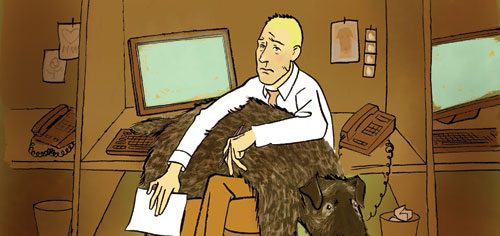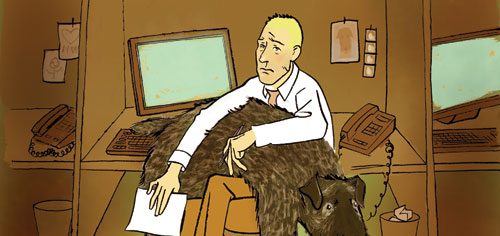

All in a Day’s Woof
Dogs in The Workplace
Water cooler conversation is changing these days. "Rex’s breath reeks of liver." "I know, he’s so delicious. But could he have his head any further up Buster’s butt? I mean, come on!" "Now, now, don’t get your hackles up. He’s just bucking for a promotion to top dog." First they were pets. Then they were family members. Now they’re becoming colleagues. Dogs in the workplace are an increasingly common phenomenon. As dog lovers, we welcome this advance. But does your pet really belong in the office? With a little planning, a good portion of common sense, and sensitivity to your colleagues, the answer is a resounding "Yes!"
It’s Bingo’s first day at work. You’re walking the Great Dane through the office, introducing him to everyone. It’s going well. Until you reach the accounting apartment. For some reason, Bingo takes an intense interest in Bill, the payroll clerk. More precisely, Bingo starts sniffing the man’s crotch intensely. You laugh nervously. Bill doesn’t laugh at all. Looks like your cheque might be late this month.
"Get him to sit," says Tara Szczygiel, the owner of Flying Dog Canine Training and Behaviour, based in Guelph, Ontario. She’s referring to Bingo, not Bill. Interrupt the dog’s quest with a Sit! command and then give him a food reward for his polite response.
The company is called Small Dog Electronics, so perhaps it’s not a complete surprise to discover that its founder, Don Mayer, has created a dog-friendly workplace. In fact, the American Psychological Association honoured the computer firm with a Psychologically Healthy Workplace Award, in large part because of Mayer’s commitment to bringing dogs into the office. Mayer is a dog lover to the core.
"My wife is my constraint on dogs. If I had my way, I’d probably have 150 dogs," he says.
Mayer has been a self-employed entrepreneur for decades. When he founded his latest venture with his son ten years ago, new employees were given the option of bringing their pets to work. As the company grew, so did the population of pups. On any given day, there are at least four or five canines wandering around, and some days will see as many as 16 at the facility in Waitsfield, Vermont.
The business owner is convinced that dogs in the office help his bottom line. Mayer points to workplace stress as one of the "most serious" issues affecting productivity: "Having dogs in a workplace leads to a much more stress-free environment."
So convinced is Mayer of the benefits of dog ownership, he even offers employees pet perks. He covers 80 percent of their veterinary bills for up to two dogs.
Cat owners, though, are out of luck. When an employee asked about insurance for a feline, Mayer just referred the employee back to the company’s name.
It takes Fifi all of half a nanosecond to take stock of the lunch room’s meager food supply: one bone, three dogs. Back home, bones on the floor clearly belong to her. Why would it be any different at work? She seizes the prize, but Happy the hound-cross-the nerve of this mongrel!-keeps sniffing around. Growls, snaps, and unhappy feelings ensue.
"If your dog is in an area with other dogs, they should not have bones or toys that trigger a resource guarding response," says trainer Szczygiel. By removing toys when dogs are together, you encourage them to interact with each other, she says. To avoid squabbles, you should also isolate dogs when they’re enjoying their favourite treats.
If you’re devoted to dogs, you know in your heart that having one at work is going to improve your quality of life. But this isn’t just anecdotal wisdom.
Stanley Coren, noted Canadian psychologist and author of books such as The Intelligence of Dogs, The Pawprints of History, and How Dogs Think, says that a number of studies in recent years point to the fact that dogs make good business sense.
Studies conducted by the Humane Society of the United States and published in 2001 and 2003 found that dogs improved staff morale and productivity, and also lowered conflict. They also found that employers who allowed dogs had a lower staff turnover.
In an American Pet Manufacturers Association-commissioned study, 50 companies which allowed dogs were compared to a sample group which did not. The result? Businesses that allowed dogs experienced 40 percent lower employee absenteeism.
Coren also points to the reams of data indicating that dogs are good for mental health. It turns out that Don Mayer was right. Dogs do decrease stress.
Say you’ve just been given a bad assignment by your supervisor. You walk back to your office, getting more and more upset. But when you get into your office, there’s your dog. As you pet the dog, Coren explains, "your heart rate slows, your breathing becomes more regular, your muscles relax [and]…your tension drains away."
You love Rex, you really do. So why do you have an intense desire to lock him in a very small, very soundproof box? Because your darling little Cocker Spaniel has been barking nonstop for exactly one hour, 47 minutes, and 16 seconds. If it’s annoying you, imagine how the guy in the next cubicle feels.
"Barking can be a sign of boredom or stress," says Szczygiel. She suggests providing interactive toys, such as Kongs, or a crate or dog bed, which can be a cozy piece of home away from home. You should also consider building up to a full day by introducing your pup to the office a few hours at a time. If the problem is too much energy, give your pup a lot of exercise before heading off to work.
Convinced yet? Of course you are. But you’re not exactly a hard sell. If you want to make certain your boss or fellow employees will enjoy having your dog around as much as you will, you’ll have to do three things: prepare, prepare, prepare. The folks over at Pet Sitters International (PSI) might be able to help with that. In June, 2005, they held their seventh annual Take Your Dog To Work Day.
According to John Long, public relations coordinator for the event, PSI wanted to "create a fun day that focuses on the positive aspects of the human-animal bond." Every year, they ask that businesses devote one day to pets and their owners- to show the public what great companions dogs are. They also want to get the message out about the wonderful dogs available in local shelters. More than 2,000 businesses and organizations participated.
The success of each location’s event comes down to organization. The first step to a successful day, says Long, is a good event coordinator. One person needs to spearhead the initiative. This advice would apply equally well to a workplace that is looking at a more permanent canine addition. The PSI reps says that workplaces that don’t plan for the arrival of Rover will probably bite off more than they can chew. Some of the concerns that he says need to be addressed include:
How will the dogs fit into the work place routine? When will they be allowed out?
Who has phobias, allergies, or just plain doesn’t like dogs?
How will they be accommodated?
Have you puppy-proofed the area? Are there poisonous plants or chemicals?
Has each dog’s environment been personalized, with toys, food, and water, and a safe, quiet area, such as a bed or crate?
Have you stocked up on high-quality cleaning supplies?
Is there an exit strategy? If your dog is unhappy, how will you remove him or her from the situation?
These six points constitute minimum preparation. You better have answers to the above questions or your first day having dogs at work may well be your last. Anticipate the worst-fights over bones, accidents, miffed colleagues-and prepare for it.
Jacqueline Whitmore’s dog accompanies her to work. But then, as owner of the Protocol School of Palm Beach, she has the luxury of working from home. The author of Business Class: Etiquette Essentials for Success at Work is an expert on smooth working relationships.
Whitmore stresses common sense and compromise when it comes to the decision to bring dogs into the office. Employees should agree as a team that they want to have dogs on site, and those who object need to be heard and offered acceptable solutions to their complaints. Agreements should be made up front about who pays for what in the event of any damages. Lastly, pet owners need to be honest: You know your dog-will Fluffy be happy at work, or an unholy terror?
Oh look, there’s my boss! No, wait, Duke. Wait! No- don’t jump up on her new suit. Oh damn. "Hi, Ms. Baker. Yes, this is my dog. Yes, his paws are quite muddy. Really? $1,400? Wow."
Szczygiel says you should keep your dog on a leash and require him to sit when he greets people. Hold onto his collar to ensure that he doesn’t jump up. "Don’t be afraid to ask approaching people to stop while you get your dog under control for a polite greeting," she says.
Don Mayer named his company Small Dog Electronics as a reminder to keep his company "small and manageable."
Why these two things? For the same reason workers increasingly want to bring their best friends to work.
"I have more fun and make more money that way." ■
Eric Sparling has written for The Globe and Mail, The Toronto Star, Oxygen, Nuvo, Modern Dog, Kennel Up!, Dogs in Canada and numerous other publications. His novella, Treading Water, is currently running in serial format in Angus magazine. Sparling lives in the Hamilton area, with his wife, Tanya (a student veterinarian), three cats, and a banned dog-Pixie, a Staffordshire Bull Terrier. For more on Ontario’s breed ban, check out www.staffordcanada.com.
Join the newsletter and never miss out on dog content again!
"*" indicates required fields
By clicking the arrow, you agree to our web Terms of Use and Privacy & Cookie Policy. Easy unsubscribe links are provided in every email.





